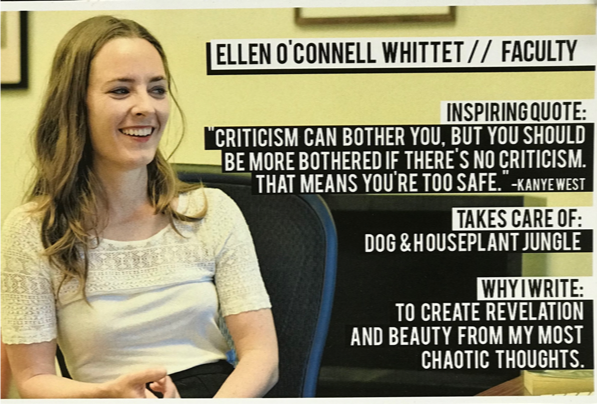By Phillip Mitchell
Ellen O’Connell Whittet never thought she would be dancing on borrowed time. The rituals of ballet were her primary concern for more than two decades.
Dancer/Essayist/Lecturer Ellen O’Connell Whittet in 2019.
Whittet began training with the Royal Ballet in London as a child, then danced with programs along the California coast including Santa Barbara Festival Ballet, UC Irvine’s dance academy, and the now-defunct company Ballet Santa Barbara.
Then, an unfortunate, career-ending injury rocked her world. A spinal fracture during a rehearsal at UC Irvine in 2005 prompted a career change for Whittet. She became a lecturer in UC Santa Barbara’s Writing Program and has turned to the fine arts and journalism in an effort to re-immerse herself in the world of ballet.
Today, Whittet looks at the art of ballet with a writer’s critical eye, given the chance to step back and observe from the outside. She has penned several essays and a book project that probes the intersection of feminism and ballet.
In a 2018 Buzzfeed news article, Whittet questioned some of the world’s most famous dance companies about their exclusion of women of color, and asked if there is a ballet company that won’t shame or hurt women who don’t fit the classical ballet archetype.
In a recent interview, she said there is still hope for her treasured art form.
“Ballet is about a century behind where they need to be, but there are some powerful trailblazers,” Whittet said. She credited dance clothing company Gaynor Minden as taking a “huge step towards greater representation and inclusion in ballet” for finally making pointe shoes for dancers of color.
Whittet’s has completed her memoir “What We Become in Flight.” She recently spoke to me about her life and work.
Q: Many of your essays and blogs revolve around ballet. What about the art keeps you interested, and what got you started in it all?
A: My dad was in London for work when I was around six, and I started training at the Royal Ballet there. The rest of my youth I continued with the Santa Barbara Festival Ballet, until I went to UC Irvine which has one of the best dance schools in the country.
Q: What can we expect from your memoir? How long have you been working on it, and what kind of contributions will it make to the Humanities and Fine Arts?
A: Nearly three years of work and research was necessary to finish it all up. I’ll reflect on my life as a dancer at the different companies, and of course my back injury at UC Irvine. I strained myself to dance after that for a while with SB Dance, but I was under intense physical pain every moment and I had to retire. The memoir will also look at the ways in which ballet acts as a pressure cooker for many women’s issues. The blogs and essays I’ve written over the course of the production served partly as some of my research into this topic.
Q: Expand on what you mean when you say ballet acts as a “pressure cooker” for women. In what ways are women exploited or excluded?
A: As ballet started in the French courts, it retains many of its “Western” ideals. Among these is the notion that the corps de ballet must be perfectly uniform. Same skin tones, heights, body types, and so on. This rationale excludes women from the art based on a racist aesthetic, at least.
The female dancers were the muses for the male choreographers. So that mindset led to the credit of a successful production going to the choreographers while dancers were cycled in and out. A lot of women of color are soloists, or principal dancers, and I would like to see the corps de ballet become more diverse as well.
Q: What advice can you give aspiring dancers or writers?
A: I hope people who may feel alienated by childhood pursuits they thought they weren’t good enough for recognize that it may not be a problem with their own body failings, but the structures within the art that keep them from succeeding. And for writers, try to augment your writing with at least one other skill or field area that you are passionate about. It gives you a fallback option and can only enhance the content you end up producing.
Phillip Mitchell is a third-year student at UC Santa Barbara, majoring in Communication . He wrote this for his class Journalism for Web and Social Media in the Writing Program.



